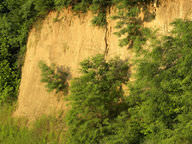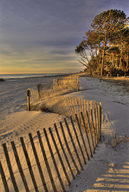2.7风的侵蚀和沉积
章节大纲
-
Lesson Objectives
::经验教训目标- Explain how wind causes erosion.
::解释一下风是如何造成侵蚀的
- Describe sediments deposited by wind.
::描述风沉积的沉积物。
- Identify ways to prevent wind erosion.
::确定防止风蚀的方法。
Vocabulary
::词汇表- loess
::液体
- sand dune
::沙沙丘
Introduction
::导言Wind is only air moving over Earth's surface, but it can cause a lot of erosion. Look at Figure . It will give you an idea of just how much erosion wind can cause. The dust storm in the photo occurred in Arizona. All that dust in the air was picked up and carried by the wind. The wind may carry the dust for hundreds of kilometers before depositing it.
::风只是在地球表面移动的空气, 但是它可能会造成大量的侵蚀。 看图。 它会给你们一个概念, 说明究竟有多少的侵蚀风可以造成。 照片中的尘暴发生在亚利桑那州。 空气中的尘埃都是由风捡起和携带的。 风在沉积之前, 可能携带着数百公里的尘埃。Dust storm over Arizona desert. Have you ever experienced a dust storm like this one?
::亚利桑那沙漠上空的沙尘暴 你经历过这样的沙尘暴吗?Wind Erosion
::风侵蚀Dust storms like the one in Figure are more common in dry climates. The soil is dried out and dusty. Plants may be few and far between. Dry, bare soil is more easily blown away by the wind than wetter soil or soil held in place by plant roots.
::像图中的尘暴那样的尘暴在干燥的气候中更为常见。土壤干涸,土土粉尘。植物可能很少,相距很远。干燥的裸露的土壤更容易被风吹走,而植物根部的湿润土壤或土壤则更容易被风吹走。How Wind Moves Particles
::风风如何移动粒子Like flowing water, wind picks up and transports particles. Wind carries particles of different sizes in the same ways that water carries them. You can see this in Figure .
::风像流水一样,风能接力和传送粒子。风能以与水相同的方式携带不同大小的粒子。图中可以看到这一点。- Tiny particles, such as clay and silt, move by suspension. They hang in the air, sometimes for days. They may be carried great distances and rise high above the ground.
::粘土和淤泥等微小颗粒通过悬浮移动,悬浮在空气中,有时长达几天,可能长途飘移,高高飞到地面上。
- Larger particles, such as sand, move by saltation. The wind blows them in short hops. They stay close to the ground.
::大颗粒,如沙子,通过盐化运动,风在短短的跳跃中吹过它们,它们离地面很近。
- Particles larger than sand move by traction. The wind rolls or pushes them over the surface. They stay on the ground.
::长于沙子的粒子通过牵引移动,风向滚动或推向表面,它们停留在地面上。
Wind transports particles in different ways depending on their size (left). A dust storm in the Middle East (right).
::风向传送粒子的方式视其大小( 左边) 不同而不同。 中东的沙尘暴( 右边 ) 。Abrasion
::面部Did you ever see workers sandblasting a building to clean it? Sand is blown onto the surface to scour away dirt and debris. Wind-blown sand has the same effect. It scours and polishes rocks and other surfaces. Wind-blown sand may carve rocks into interesting shapes. You can see an example in Figure . This form of erosion is called abrasion. It occurs any time rough sediments are blown or dragged over surfaces. Can you think of other ways abrasion might occur?
::你有没有见过工人用沙子打扫一栋建筑?沙子被吹到表面以扫走泥土和瓦砾。风沙具有同样的效果。它会刮刮和抛光岩石和其他表面。风沙会把岩石雕刻成有趣的形状。你可以看到图中的例子。这种侵蚀形式被称为擦伤。它随时会发生粗沉积被吹过或拖过表面。你能想到其他的磨擦方式吗?Sand blown by fierce winds have carved this rock into an interesting shape.
::暴风吹起的沙子 将这块岩石雕刻成一个有趣的形状Wind Deposition
::风向沉积Like water, when wind slows down it drops the sediment it's carrying. This often happens when the wind has to move over, or around, an obstacle. A rock or tree may cause wind to slow down. As the wind slows, it deposits the largest particles first. Different types of deposits form depending on the size of the particles deposited.
::与水一样,当风慢下来时,风会让它所携带的沉积物落下。当风必须向上移动或绕过障碍物时,这种情况经常发生。岩石或树可能导致风慢下来。随着风慢下来,它首先沉积最大的粒子。不同种类的沉积形式取决于沉积的粒子大小。Deposition of Sand
::沙沙沉积When the wind deposits sand, it forms small hills of sand. These hills are called sand dunes . For sand dunes to form, there must be plenty of sand and wind. Sand dunes are found mainly in deserts and on beaches. You can see examples of sand dunes in Figure .
::当风将沙堆积成沙丘时,沙丘会形成小沙丘。这些山丘被称为沙丘。要形成沙丘,必须有足够的沙丘和风。沙丘主要在沙漠和海滩上发现。您可以看到图中沙丘的例子。Sand dunes form where the wind deposits sand. (A) Desert sand dunes. (B) Sand dunes line many beaches like this one in Australia.
:A) 沙漠沙丘。 (B) 沙丘排在澳大利亚许多海滩上,
How Sand Dunes Form
::沙丘如何形成What causes a sand dune to form? It starts with an obstacle, such as a rock. The obstacle causes the wind to slow down. The wind then drops some of its sand. As more sand is deposited, the dune gets bigger. The dune becomes the obstacle that slows the wind and causes it to drop its sand. The hill takes on the typical shape of a sand dune, shown in Figure .
::是什么导致沙丘形成?它始于一个障碍,如岩石。障碍导致风速减慢。然后,风将一些沙子落下。随着沙土沉积,沙丘会变大。沙丘会成为减缓风速并导致沙丘落下的障碍。山丘以图所示沙丘的典型形状形成。A sand dune has a gentle slope on the side the wind blows from. The opposite side has a steep slope. This side is called the slip face.
::沙丘的侧面有一个温和的斜坡, 风从侧面吹来。 反面的侧面有一个陡峭的斜坡。 右侧称为滑雪脸 。Migration of Sand Dunes
::沙丘迁徙Once a sand dune forms, it may slowly migrate over the land. The wind moves grains of sand up the gently sloping side of the dune. This is done by saltation. When the sand grains reach the top of the dune, they slip down the steeper side. The grains are pulled by gravity. The constant movement of sand up and over the dune causes the dune to move along the ground. It always moves in the same direction that the wind usually blows. Can you explain why?
::沙丘形成后, 沙丘会慢慢地在陆地上移动。 风把沙粒移到沙丘的轻滑侧端。 这是盐化的结果。 当沙粒到达沙丘的顶部时, 沙丘滑落到更陡的侧面。 粒子会通过引力拉动。 沙丘的不断移动使沙丘沿着地面移动。 它总是沿着风通常吹向的方向移动。 你能解释为什么吗 ?Loess
::乐When the wind drops fine particles of silt and clay, it forms deposits called loess . Loess deposits form vertical cliffs. Loess can become a thick, rich soil. That's why loess deposits are used for farming in many parts of the world. You can see an example of loess in Figure .
::当风落下细细的淤泥和粘土粒子时,它会形成称为“懒惰”的矿床。 懒惰的矿床会形成垂直的悬崖。 懒惰的土壤会变得密密, 肥沃的土壤。 这就是为什么在世界许多地区, 懒惰的矿床会被用于耕种。 您可以在图中看到一个“懒惰”的例子。Loess cliffs in Mississippi.
::密西西比州的悬崖Preventing Wind Erosion
::防止风侵蚀It's very important to control wind erosion of soil. Good soil is a precious resource that takes a long time to form. Covering soil with plants is one way to reduce wind erosion. Plants and their roots help hold the soil in place. They also help the soil retain water so it is less likely to blow away.
::控制风蚀土壤非常重要。 良好的土壤是一种宝贵的资源, 需要很长时间才能形成。 用植物覆盖土壤是减少风蚀的一种方法。 植物及其根部能帮助土壤保持原地。 它们也帮助土壤保留水, 因而它不太可能被吹走。Planting rows of trees around fields is another way to reduce wind erosion. The trees slow down the wind, so it doesn't cause as much erosion. Fences like the one in Figure serve the same purpose. The fence in the figure is preventing erosion and migration of sand dunes on a beach.
::在田野周围种植一排树木是减少风蚀的另一种方式。 树木减慢风速, 因而不会造成同样的侵蚀。 图中的栅栏有着同样的目的。 图中的栅栏就是防止沙丘在海滩上的侵蚀和迁移。Protecting Sand Dunes from Wind Erosion. Many beaches uses fences like this one to reduce wind erosion of sand. If plants start growing on the dunes, they help hold the sand in place.
::保护沙丘免受风蚀。 许多海滩使用这样的栅栏来减少沙子的风蚀。 如果植物开始生长在沙丘上,它们会帮助沙子保持原地。Lesson Summary
::经验教训摘要- Dry, bare soil is more likely to be eroded by the wind than moist soil or soil covered with plants.
::干燥、裸露的土壤比湿润的土壤或植物覆盖的土壤更有可能被风侵蚀。
- How wind carries particles depends on their size. The sediment in wind causes erosion by abrasion.
::风中的沉积会因磨损而侵蚀。
- Sand dunes form when the wind deposits sand. Loess form when the wind deposits clay and silt.
::风 存 沙 子 、 沙 子 便 成 沙 子 . 风 存 土 和 淤 泥 、 风 存 沙 子 便 成 沙 子
- Wind erosion can be prevented by keeping the ground covered with plants. They help hold the soil in place. Rows of trees and fences can help by slowing the wind.
::风蚀可以通过保持土壤覆盖植物来防止,它们有助于保持土壤原地不动,树木和栅栏的一行可以减缓风速,从而帮助防止风蚀。
Lesson Review Questions
::经验回顾问题Recall
::回顾- How does the wind carry particles of sand?
::风如何携带沙粒?
- What is abrasion?
::什么是擦伤?
- What are sand dunes? Where are they found?
::什么是沙丘 在哪里找到的
- Describe loess.
::描述 loess 。
- Identify two ways to reduce wind erosion.
::确定两个减少风蚀的方法。
Apply Concepts
::应用概念- Wind-blown snow forms drifts that are similar to sand dunes. Apply lesson concepts to infer how you could reduce snowdrifts in a driveway.
::风雪形成与沙丘相似的漂移。 应用课程概念来推断如何减少车道中的滑雪。
Think Critically
::仔细仔细思考- Compare and contrast how the wind transports clay, sand, and pebbles.
::对比和对比风是如何输送粘土、沙子和石子的。
- Explain why a sand dune migrates.
::解释沙丘迁徙的原因。
Points to Consider
::需要考虑的要点Abrasion is the main way that wind causes erosion. The next lesson explains how glaciers cause erosion.
::磨损是风导致侵蚀的主要方式。 下一个教训解释了冰川如何造成侵蚀。- How do you think glaciers cause erosion?
::你认为冰川会如何造成侵蚀?
- Do you think glaciers might erode by abrasion, like the wind?
::你觉得冰川可能会像风一样 被磨损侵蚀吗?
- Explain how wind causes erosion.






